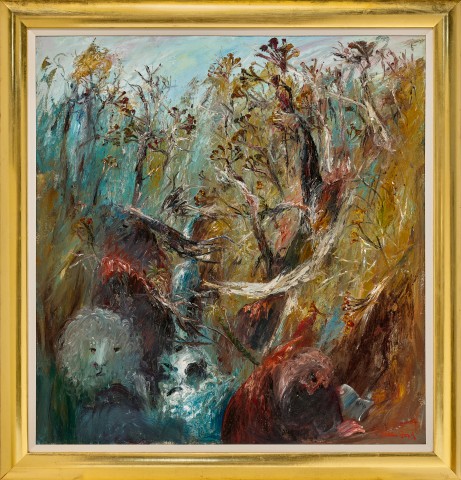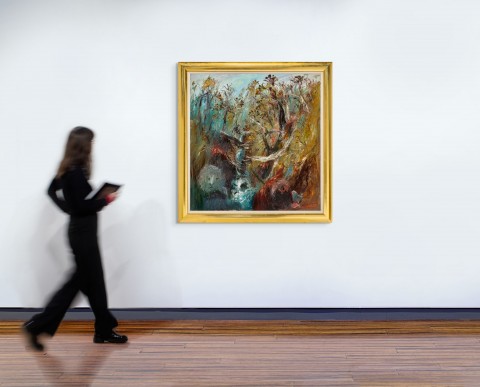St Jerome, c.1968
Arthur Boyd
oil on canvas
114.5 x 108.5 cm
signed lower right: Arthur Boyd
Eddie Glastra Gallery, Sydney
Private collection, Sydney, acquired from the above in 1997
At the close of the 1960s, Arthur Boyd had already been living continuously as an expatriate in London for ten years, his reputation as a contemporary artist on the international stage in ascendancy. Here, he had fortified his strong allegiance to the traditions of European paintings, visiting original works by masters hitherto only accessible through printed reproductions. Christian iconography had been embedded in Boyd’s imagination from an early age through the ritual reading of biblical stories to him by his grandmother, Emma Minnie Boyd (1858 – 1963).1 These familiar narratives were again brought to the fore with Italian paintings from the Trecento seen during his visit to the towns of Assisi and Gubbio in 1964. Seizing on a friendship and association with the medievalist art historian Thomas S. R. Boase (a former director of the Courtauld Institute of Art and President of Magdalen College, Oxford), Boyd embarked on a series of highly inventive responses to the stories of Saint Francis and, later, the Babylonian king, Nebuchadnezzar. Likely created in parallel to this celebrated series depicting the banished king, Boyd’s vigorous painting of Saint Jerome similarly presents a penitent figure exiled in an inhospitable wilderness, hounded by threats unseen.
Arthur Boyd found a renewed vigour for painting around 1966, generating energetic works in sustained narrative suites. Subsequent expressive paintings, including St Jerome, saw Boyd delve back into his ample visual vocabulary, creating images that blended man, beast and the landscape. Importantly, Boyd yielded to his audience’s free association, cautioning, ‘if you look at my pictures and wonder what they are about, they are mostly about animals and people [...] they really have little to say unless the person looking at them is able to make up a story.’2 Saint Jerome nevertheless appears within Boyd’s painting with traditional attributes: in the red robes of a cardinal, bent over the Bible. Both he and his companion, a lion (who, according to hagiographical belief, had been tamed by Jerome’s removal of a thorn from its paw), seem impervious to the creeping forest and a ghostly apparition that surges from the darkness. In contrast to the snarling beast who had pursued Nebuchadnezzar in the wilderness, the silvery lion in this painting now provides Jerome with serene companionship.
The story of Saint Jerome was particularly popular in 15th-century European art, establishing an iconography in which the site of his exile, the Syrian desert, was transformed into a temperate wooded landscape. With the textured, rapid brushwork, Boyd’s tangled wood rises on either side of the canvas, creating an enveloping structure of trees reminiscent of the threatening forest in Nebuchadnezzar caught in the forest, 1968 (Art Gallery of South Australia) and the earlier Hunter by a creek, 1966. Almost indistinguishable from this dense vegetation, the wizened, bearded form of the saint is depicted in profile, bent over his work. Although identified here as Saint Jerome, the figure of a pilgrim alone in nature, save for the watchful presence of an animal, is featured often in Boyd’s paintings. Echoing the saint’s own teachings, Boyd questioned the validity of materialistic greed and rapid urbanisation.3 He presents in these works visual expressions of his search for truth and freedom in a disordered world.
1. Hoff, U., The Art of Arthur Boyd, Andre Deutsch, London, 1986, p. 83
2. Arthur Boyd, cited in Pearce, B., Arthur Boyd Retrospective, Art Gallery of New South Wales, Sydney, 1993, p. 15
3. Gunn, G., Arthur Boyd. Seven Persistent Images, Australian National Gallery, Canberra, 1985, pp. 34 – 37
LUCIE REEVES-SMITH


